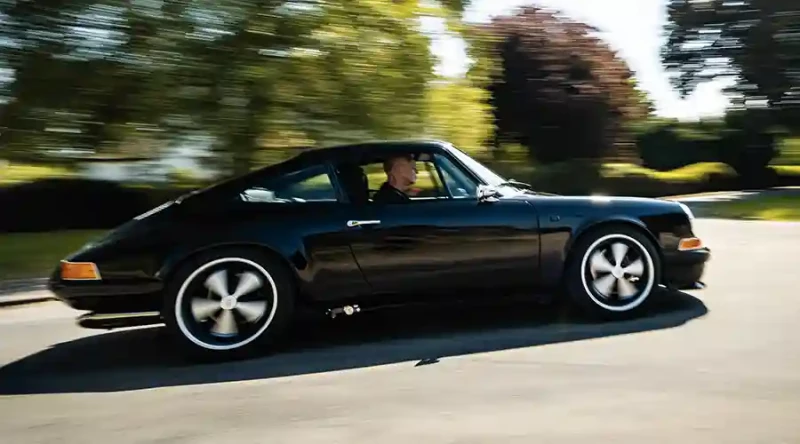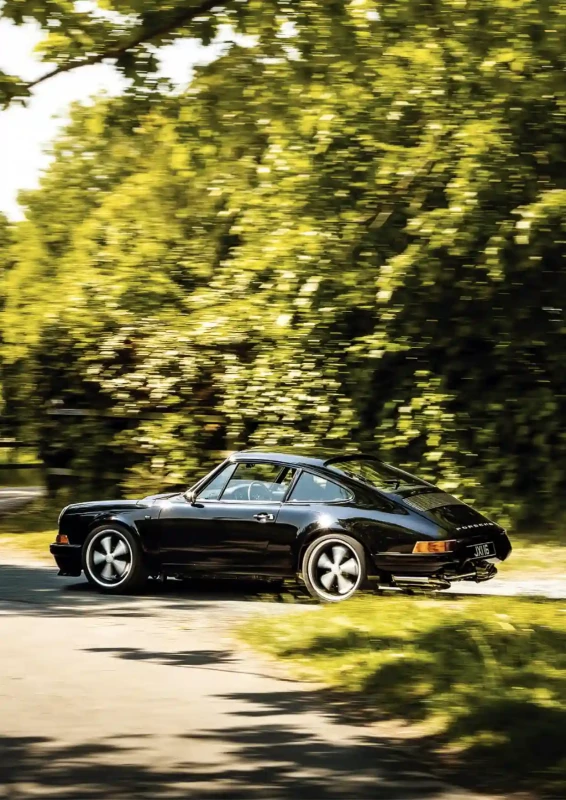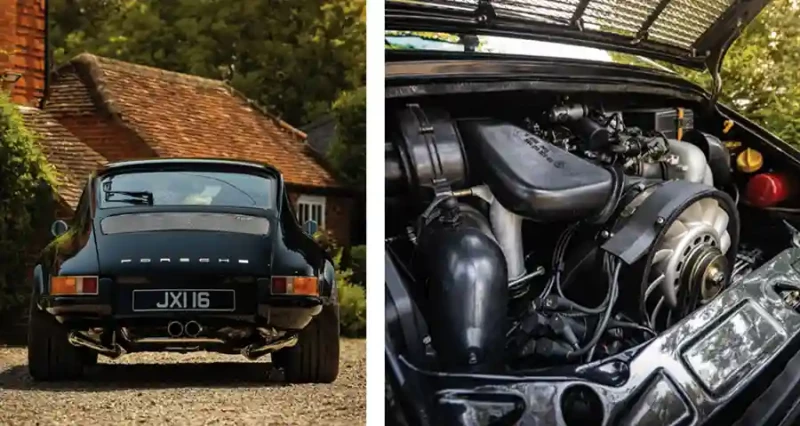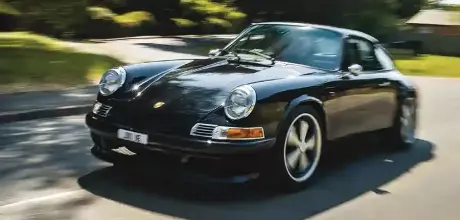Rindt’s latest Porsche 911 Carrera 2 964 restomod
Why is the 964 the sweet spot of the 911 restomod scene? For good reason, as wediscover with another 964-based build from Rindt Vehicle Design...
Words Steve Bennett
Photography Simon Jessop
BACK IN BLACK
Here’s a thing. Trundling down the M11 motorway in no particular hurry, I clocked a car transporter up ahead. Given I was approaching at a speed near parity, I had time to take in the load. From a quarter-mile back, my eagle Porsche eye registered eight classic 911s finished in red, white and black. I considered this unusual, but taking a swig of Costa and getting closer, it became apparent all were 964s in either Coupe or Cabriolet specification. Not exactly a coffee-spitting moment, but certainly a penny-dropping one, especially considering I was en route to visit Rindt Vehicle Design, where I’d drive the black 964 restomod you see on these pages.

There can be no doubt as to the fate of the transported 964s. Rather like porkers to market, while they weren’t going to be culled as such, they were certainly off to be chopped up or given a Frankenstein makeover. I’d heard of the 964 round-up and obviously know of the premium this generation of 911 commands on the restomod scene, but seeing the evidence was kind of sobering, even if I’m not quite sure why.
IT DRIVES WITH JUST THE RIGHT AMOUNT OF MODERNITY, MORE SO THAN ANY G-SERIES CAR, EVEN A LATE CARRERA 3.2
Porsche built close to sixty-three thousand 964s and, as is the way of the 911, most of them are still on the road. Not exactly rare, then. Singer Vehicle Design, the biggest player in the 964 restomod game, capped production of its Classic Study at 450 cars and is producing its Dynamics and Lightweighting Study and 935-inspired builds in much smaller numbers. Bottom line, the pool of 964s isn’t going to dry up any time soon, meaning there’s plenty of room for those who want their 964 as it left the factory or otherwise.

Satisfied with this train of thought, I pondered why it was the 964 (above other 911 derivatives), which become the de facto model of choice for the restomod scene. Certainly, a specific type of restomod. Why not the Carrera 3.2, SC or even the later 993? I guess it probably comes down to the fact that back in the late 1990s and early 2000s, 964s could be acquired at rockbottom prices. This was the unloved Porsche. Folk didn’t feel too precious about modifying this generation of 911, whether bolting on a supercharger or mimicking the look of an RS. The 964 became the epicentre of the 911 modifying scene. In contrast, as the last of the air-cooled 911s, the 993 became untouchable. Plus, of course, its bodywork changes were far more fundamental and difficult to reverse.

Within the term ‘restomod,’ ‘mod’ can mean both modified and modern. What the 964 had over the G-series 911 was its fundamentally more modern underpinnings, which made creating a modern-drivingbut- classic-looking 911 far more achievable. Well, the driving bit, at least. Think 250bhp and four-wheel drive in Carrera 4 form, plus such niceties as power steering and a slick Getrag G50 gearbox. The problem early pioneers of the 964 backdate had to wrestle with was ridding the car of its modernist panels and developing a pre-1974 look. This had to be done cost-effectively because, relatively speaking, there simply wasn’t much money in the Porsche scene — consider the fact a 964 would most likely set you back less than ten grand. Oh, and there was also the small matter of the car’s wheels. Authentic Fuchs, even in Turbo form, wouldn’t fit because the offset was completely different to that of 964 wheels.
ARCHES REMAIN AS PORSCHE INTENDED, ALBEIT MODIFIED TO ACCEPT VINTAGE-STYLE REAR LIGHTS AND INDICATORS
Solutions were found, panels moulded and fabricated, Fuchs replicas created, but while a 964 could achieve the classic 911 look, it could never be a foolproof replica, which is effectively what liberated 964 hot-rodders, restomodders and backdaters. That was then and this is now. Today’s Porsche scene is radically different, but the 964 remains the go-to 911 ‘blank canvas’. Restomodding wasn’t really a thing in the mid-2000s (forward-dating was arguably more common), but it’s now pretty much mainstream. Moreover, the quality of cars starts high and doesn’t appear to have any limits, the appeal to owners being a 911 configured to their exacting specification.

That’s the meanderings a transporter load of 964s can generate, but it’s time to get to grips with Rindt Vehicle Design’s black beauty. In the royal environs of Windsor (and less glamorously, Slough), behind electric gates and down a long farm road, this boutique Porsche restoration business operates out of heavily beamed and vaulted farm buildings. It’s fair to say Rindt has been a rich source of Classic Porsche feature cars in recent times, primarily because the business produces these kind of cars at a rate of knots, a result of a big team taking care of all work in-house.
As ever, when walking into the company’s main build area, I’m struck by the line-up of freshly painted bodyshells. Each has been restored and painted onsite in Rindt’s own body shop and in one of two paint booths, the second of which has only recently come on stream and was established in response to demand from Porschephiles wanting corrective bodywork for their cars, rather than full restoration or a bespoke build. As we’ll learn with the black 964, pretty much nothing is beyond saving when you have these resources and expertise at your disposal — most Rindt 911 shells will spend at least a couple of months on a Celette chassis jig, while those requiring major metalwork can be bolted down and remain in situ for considerably longer as their skeletal-like remains are slowly transformed into complete cars.
PARTS OF THE PROCESS
Alongside each shell is an accumulated collection of components patiently waiting to be attached. I turn right at the end of the line and I’m presented with Rindt’s engine build shop, where each car’s power can be realised by way of anything from the assembly of a standard air-cooled flat-four to one of the firm’s signature four-litre supercharged flat-sixes. I continue retracing my steps to be met with every facet of 911 restoration, from suspension to wiring to trimming — the in-house upholstery department is a thrum of activity, filled with the sound of whirring sewing machinery and decorated with rolls of standard and custom fabrics, leather and Alcantara. It’s a production line of sorts, each Rindt employee an expert in their artisanal craft.
Rindt boss, Brian Richardson, is on hand to talk us through this 964 build. I can’t resist mentioning the transporter of 911s I spotted earlier. He’s aware of such practice, but has somewhat different take on the donor car theme. “Buy the worst car you can find,” he maintains. Come again? “If it’s going to be stripped back to its bare bones, receive new panels and every component is going to be rebuilt, refurbished or replaced, then there is absolutely no point in starting with a near mint 911 setting you back more than sixty thousand pounds.” He has a point. Ably demonstrating it is our test car, a 964 which arrived at Rindt covered in rust. Indeed, it spent nearly four months on the jig before a further six to eight weeks on the receiving end of eleven coats of primer and black topcoat.
Prior to paint, the car had to go through the transformation from standard 964 Carrera 2 to the pre- 1974 look, a process Rindt is well-versed in. At the front end of the Porsche, the standard 964 bonnet is extended for the long bonnet look, as is the slam panel. Room up front has to be accommodated for a Classic Retrofit air-conditioning system. The front bumper and spoiler combo is Rindt’s own design, while the front wings are modified to take classic-style indicators and horn grilles. At the rear, the arches remain as Porsche intended, albeit modified to accept vintage-style rear lights and indicators. The quarter bumpers are manufactured by Rindt and widened to blend with the rear arches. Staying at the back of the car, it’s impossible to miss the custom exhaust system in all its bent chrome glory. I can’t wait to hear what it sounds like.
This isn’t supposed to be a ‘dead ringer’ replica of an old-school 911, which is why the window trim remains satin black, rather than chrome. A subtle touch. Brightwork, such as it is, extends to the door handles, rear grille, bullet-style door mirrors and Porsche script on the engine lid. Rather like the exhaust, it’s hard not to miss the eighteen-inch Group 4 Fuchs replicas. Where would the 911 restomod scene be without these deepdish beauties?
Power comes courtesy of a standard 3.6-litre M64 flat-six, although it must be noted the exhaust might be liberating a few extra horses over the standard near 250bhp. When it comes to engine output, for those of you adopting a ‘more is more’ attitude, it’s worth acknowledging the fact a standard 964 boxer perfectly mixes torque with revs for the road and offers the kind of effortless performance often sacrificed for big numbers. Needless to say, this 911’s engine has been fully rebuilt, with new bearing shells, piston rings, camshafts and gaskets. For optimum ignition, the 964’s twin dizzy setup has also been refreshed.
Likewise, the G50 gearbox remains standard, but has been rebuilt with new components, including a new clutch, as required. Suspension is stock, comprising new dampers and bushes. All components have been painted or plated. Brakes are the efficient, standard four-pots, which benefit from new fluid transfer pipework. Peer underneath from the rear, and the car’s underpinnings are as reflective as the gloss black bodywork. The interior is nicely understated — you can’t go wrong with black. Standard ‘tombstone’ seats have been retrimmed in black leather with contrasting grey Alcantara centres.
RS door cards add a lightweight touch and conceal custom speakers linked to a retrolooking Blaupunkt DAB head unit. The dashtop is trimmed in leather, and the aluminium-rimmed dials are set into a gloss black binnacle. If we’re being picky, then perhaps the wood-rimmed steering wheel would be more in place in a Jaguar D-Type, but then again, part of the joy of building a restomod is personalising it, so who am I to judge? And, I admit, it’s refreshing not to be met with the ubiquitous MOMO Prototipo. Besides, the steering wheel complements the tactile delights of the machined, glossvarnished and perfectly spherical wooden gear knob. As ever, it’s all about the details.
Talking of which, let’s do a quick walkaround before taking this 911 for a spin. After all, the overall effect really is quite stunning — black when applied as faultlessly as this never fails. The paintwork offers an almost beguiling level of depth and gloss. The big Group 4 Fuchs add a Hot Wheels vibe, as does the statement exhaust. Looking at the rear end, it’s easy to imagine this Porsche strutting its stuff along the quarter-mile at Santa Pod. A 265/35 tyre profile might not sound wide in modern terms, but it certainly fills the rear arches of a classic 911.
All show and no go? Maybe, but why not? When all is said and done, this is still an air-cooled 911, and a mechanically standard 964 at that, but the purist in me says those eighteen inchers shouldn’t work on stock suspension. As it happens, they work just fine. Sure, power-assisted steering helps, but there is no sting to the ride quality, and while I didn’t really have much of an opportunity for cornering heroics, the grip afforded to this 964 is nothing short of immense. The exhaust? It bellows, but in a good way. At cruising speed, it fades into the background.
After all the pondering and deliberation, what really strikes home is exactly what 964 restomod pioneers knew all along: this is the sweet spot of 911 donors for those who don’t want or need to slavishly recreate the 911 back catalogue. It drives with just the right amount of modernity, more so than any G-series car, even a late Carrera 3.2, which feels genuinely classic by comparison. And let’s not worry. There are still plenty of 964s to go around. Indeed, we should be grateful Porsche built so many. Yep, whether our taste is standard or restomod, we can all have our cake and eat it. Talking of which, Rindt Automotive Design will be more than happy to build you a 964 to whatever specification you desire. We’ll be back here soon — whatever that four-litre supercharged motor is heading into the back of, we need to try it.
Above Big ol’ Group 4 wheels provide the juxtaposition of a modern twist on a classic Porsche wheel design.
Above M64 has been rebuilt and makes itself known through a bespoke stainless steel exhaust system.
Above and below Woodrimmed steering wheel is an acquired taste in a 964, but isn’t alone — the Rindtbranded gear knob does its best to blend vintage style with that of a modern-classic
Above Largely standard mechanicals mean this 964 isn’t as outlandish as some of the backdates leaving the Rindt Vehicle Design workshop in recent times.


